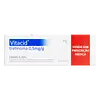What's inside
What's inside
 Key Ingredients
Key Ingredients

 Benefits
Benefits

 Concerns
Concerns

 Ingredients Side-by-side
Ingredients Side-by-side

Niacinamide
SmoothingTocopheryl Acetate
AntioxidantAscorbic Acid
AntioxidantPPG-7/Succinic Acid Copolymer
Ammonium Acryloyldimethyltaurate/Vinyl Formamide Copolymer
Emulsion StabilisingImidazolidinyl Urea
PreservativePropylene Glycol
HumectantDisodium EDTA
Cetearyl Alcohol
EmollientPolysorbate 60
EmulsifyingPetrolatum
EmollientPPG-14 Butyl Ether
Skin ConditioningBHT
AntioxidantDecyl Oleate
EmollientOleth-10 Phosphate
Dicetyl Phosphate
EmulsifyingMethylparaben
PreservativeEthylparaben
PreservativePropylparaben
PreservativeButylparaben
MaskingPhenoxyethanol
PreservativeDimethiconol
EmollientCyclopentasiloxane
EmollientCyclomethicone
EmollientParfum
MaskingWater
Skin ConditioningNiacinamide, Tocopheryl Acetate, Ascorbic Acid, PPG-7/Succinic Acid Copolymer, Ammonium Acryloyldimethyltaurate/Vinyl Formamide Copolymer, Imidazolidinyl Urea, Propylene Glycol, Disodium EDTA, Cetearyl Alcohol, Polysorbate 60, Petrolatum, PPG-14 Butyl Ether, BHT, Decyl Oleate, Oleth-10 Phosphate, Dicetyl Phosphate, Methylparaben, Ethylparaben, Propylparaben, Butylparaben, Phenoxyethanol, Dimethiconol, Cyclopentasiloxane, Cyclomethicone, Parfum, Water
 Reviews
Reviews

Alternatives
Ingredients Explained
These ingredients are found in both products.
Ingredients higher up in an ingredient list are typically present in a larger amount.
BHT is a synthetic antioxidant and preservative.
As an antioxidant, it helps your body fight off free-radicals. Free-radicals are molecules that may damage your skin cells.
As a preservative, it is used to stabilize products and prevent them from degrading. Specifically, BHT prevents degradation from oxidation.
The concerns related to BHT come from oral studies; this ingredient is currently allowed for use by both the FDA and EU.
However, it was recently restricted for use in the UK as of April 2024.
Learn more about BHT